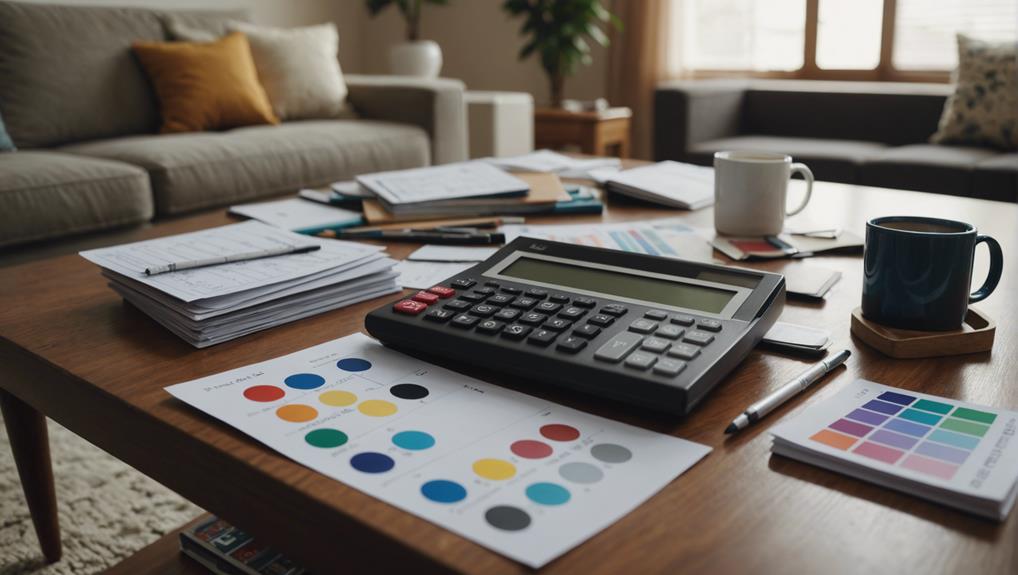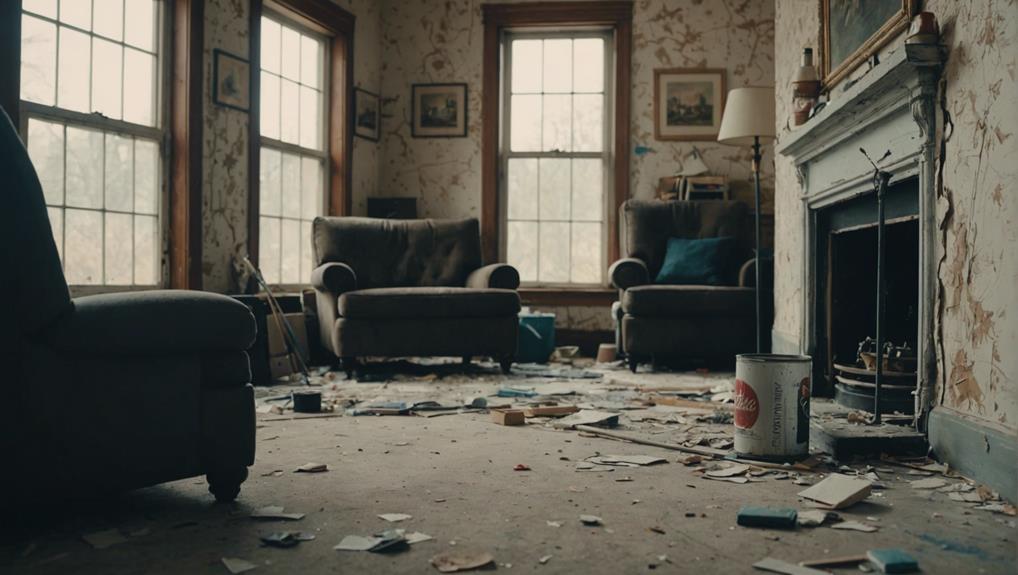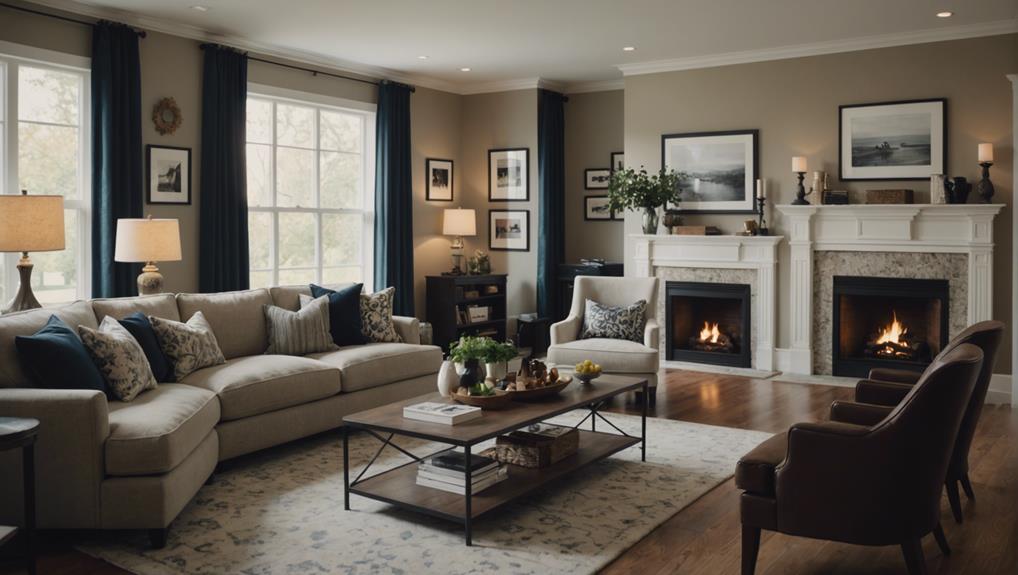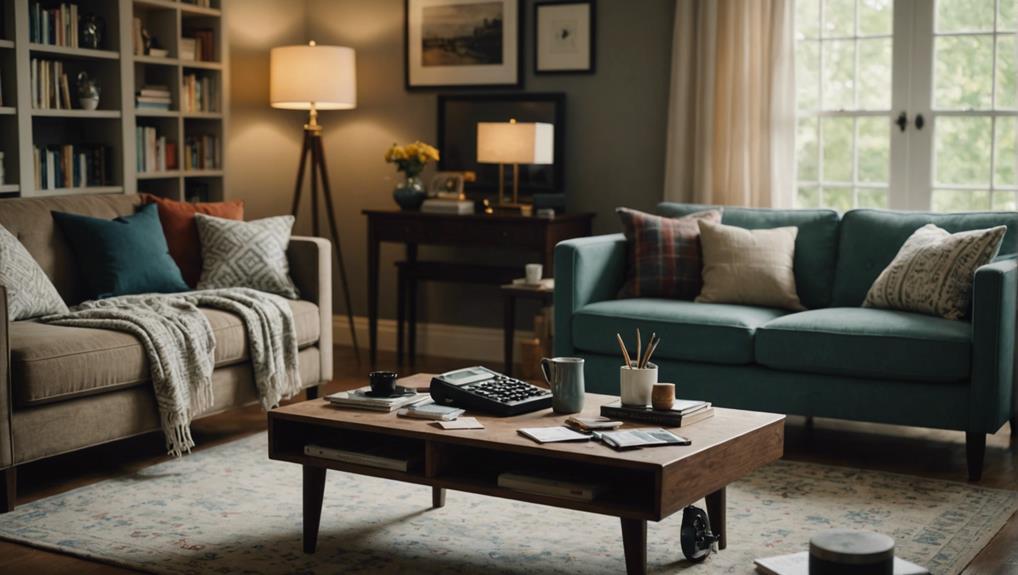When you decide to stage your home in the UK on your own, you're looking at spending £1,050 to £3,400, depending on your choices. You'll need to allocate about £50 to £100 for initial tools and £200 to £500 for decorations. Consider renting bigger furniture pieces and don't forget about £10 to several thousand for necessary repairs to spruce up your space.
Beyond the cash, prepare yourself for a significant time investment—50 to 100 hours for decluttering, cleaning, and staging. But with the right touch, you could significantly enhance your home's market value. There's more to discover on optimising these efforts effectively.
Assessing DIY Costs

To evaluate DIY home staging costs effectively, you'll need to take into account everything from paint and cleaning services to the potential rental of furniture and decor. Imagine transforming a space with just a few strategic tweaks, where the right shade of paint and a well-placed sofa can skyrocket your property's market appeal.
You're likely aiming for maximum impact with minimal outlay. Budget-friendly DIY staging might mean revamping walls with a vibrant coat of paint, which can dramatically alter a room's perception for just the cost of a few tins. Add to that the cost of deep cleaning to make sure every corner sparkles, and you're creating an inviting atmosphere buyers can't resist.
Consider the possibility of renting contemporary furniture to give your space a modern edge. While this can add to your upfront costs, the investment could be vital in staging a home that stands out. Don't forget, you might also find yourself buying additional decor or storage solutions to declutter and depersonalise each room, making it easier for potential buyers to envision themselves in the space.
Balancing these costs against the potential increase in sale price is key. It's about being smart with your choices, leveraging what you already own, and knowing when to invest in that extra flair that seals the deal.
Time Investment Breakdown
Undertaking DIY home staging can save you money and increase the value of your property, but it does require a significant time commitment, typically ranging from 50 to 100 hours depending on various factors. You'll be involved in a range of tasks, each demanding a portion of your time. Let's delve into what this process entails.
Firstly, decluttering. This involves strategically clearing spaces to ensure potential buyers can envision themselves in your home. You can expect to spend around 5-10 hours on this task, depending on the amount of belongings you have accumulated over the years.
Next, cleaning. These 5-10 hours will go beyond a standard tidy-up. It will involve deep cleaning, reaching into corners, behind furniture, and all areas in between to make the place shine.
The majority of your time will be dedicated to the staging itself. This will take around 30-80 hours. Tasks include rearranging furniture, possibly painting walls, and refining decor to appeal to buyers' preferences. Additionally, you may spend 5-10 hours researching the latest staging tips and techniques to ensure your approach is thorough and up-to-date.
Material and Tool Expenses
When it comes to staging your home to increase its value and sell quicker in the UK, you'll encounter a range of costs for materials and tools. These costs can vary significantly, from £1,050 to £3,400, depending on the scope of your project and the finishes you opt for. To begin, investing in essential tools and materials will require an initial expenditure of approximately £50 to £100. These tools, including paint brushes, rollers, and sandpaper, are essential for transforming your spaces effectively.
In addition to tools, consider the decorative elements that breathe life into a room. Allocating £200 to £500 for items like cushions, artwork, and plants can significantly enhance the visual appeal of your property, capturing the interest of potential buyers. It's not just about filling spaces, but about crafting an atmosphere that resonates with viewers.
If your staging plan involves larger furniture pieces, you may need to budget for renting items. This expense can range from £300 to £800, depending on the property's size and the quality of the furniture. Keep in mind that the aim is to create an appealing, marketable home environment without making permanent investments in high-cost furnishings. Striking a balance between cost and impact is key to achieving the best possible outcome.
Professional Consultation Fees
Considering professional consultation for your DIY home staging project can be a cost-effective strategy, with fees typically ranging between £50 and £200. It's important to weigh the benefits of tapping into the expertise that a seasoned consultant brings to the table. You might find that the initial meeting cost could be deducted from further work fees, making it a smarter financial move.
It's worth noting that consultation costs can vary based on the consultant's experience and qualifications. Opting for a more experienced consultant might seem pricey initially, but their insights could potentially skyrocket the value of your property. They're not just offering advice; they're providing a strategic blueprint tailored to make your home more appealing to buyers.
Moreover, if you decide to go beyond the consultation and engage hands-on staging services, costs for DIY projects can be reasonable, typically running from £20 to £75 per hour. Remember, these fees are often calculated as a proportion of the potential increase in the property's sale price. This pricing model aligns the consultant's incentives with your goal – maximising the sale price. It's a partnership where both sides have a stake in the financial outcome, pushing innovative solutions to the forefront.
Potential Repair Costs

Before delving into decorative touches and furniture arrangement, it's important to address potential repair costs, which can range from £10 for minor fixes to 1-2% of your home's value for more substantial repairs. When you're staging your home yourself, overlooking these costs can quickly derail your budget and timeline.
Let's break it down. You'll want to start by evaluating every nook and cranny of your property. Identify areas that need attention—perhaps it's a leaky faucet, a cracked tile, or a wall in need of a fresh coat of paint. These minor updates not only prevent buyer objections but also boost the overall aesthetic appeal, making your home feel more welcoming.
Investing in these small repairs can be a strategic move. It puts you in control, allowing you to manage expenses while maximising impact. Think of it as fine-tuning your home's first impression. By fixing these minor issues, you're ensuring that potential buyers focus on the home's strengths, not its minor flaws.
Estimating Overall Value Impact
To assess the overall impact of DIY home staging on the value of your property, it's important to consider how potential returns can outweigh the initial costs. Picture investing just 1-2% of your property's value into staging and achieving significantly higher selling prices. It's not just about aesthetics; it's about a savvy financial strategy. By allocating £10,000 to £15,000 for a complete makeover, you're not simply spending money—you're strategically investing to enhance your home's appeal and marketability.
Commencing with a professional consultation costing around £300 may seem like an additional expense, but it's a vital step. This expert advice tailors your staging efforts, ensuring you maximise every pound spent. Keep in mind, successful staging not only boosts the selling price but can also accelerate the selling process, reducing the costs linked to a prolonged market presence.
Now, imagine this: what if your staging efforts amplify your home's value by more than the average? Innovative staging solutions could distinguish your property in a competitive market, presenting a fresh look that immediately captures buyer interest. You're not just selling a space; you're offering a potential lifestyle, and that's where the true value lies.
Comparing DIY Vs Professional Staging

When deciding between DIY and professional home staging, you must consider the cost-effectiveness versus the expertise provided. Professional staging might consume 1-3% of your property's selling price, but it brings a level of polish that's hard to match. These stagers charge anywhere from £20 to £75 per hour, and full services can reach up to £5,000, depending on your home's size and condition.
On the other hand, opting for the DIY route could significantly reduce costs. You'll only have minor expenses for items like paint and lighting fixtures. If you have a talent for design and some stylish furniture, you could revamp your space without the hefty price tag. It's not just about saving money; it's about seizing control and infusing your personal touch into every corner.
However, remember that time is money. DIY staging requires a substantial investment of your time and effort. If you're ready for the challenge, it can be a fulfilling project that not only saves pounds but also makes your property stand out as 'unique' among staged homes. So, assess your options, evaluate your skills and schedule, and choose the path that aligns with your goals and resources.
Conclusion
You've explored the costs and efforts of DIY home staging in the UK, considering time, materials, and potential consultations.
Remember, while doing it yourself can save you money upfront, hiring a professional stager might offer better value in enhancing your home's market appeal.
Consider the balance between your time investment and the potentially higher returns with professional assistance.
Ultimately, the decision depends on your budget, skill level, and how quickly you want to sell your home.

